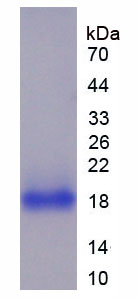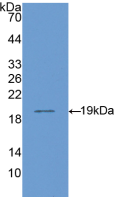Active Cluster Of Differentiation 14 (CD14) 

Monocyte differentiation antigen CD14; Myeloid cell-specific leucine-rich glycoprotein
- UOM
- FOB US$ 336.00 US$ 840.00 US$ 1,680.00 US$ 5,040.00 US$ 12,600.00
- Quantity
Overview
Properties
- Product No.APA685Hu01
- Organism SpeciesHomo sapiens (Human) Same name, Different species.
- ApplicationsCell culture; Activity Assays.
Research use only - DownloadInstruction Manual
- CategoryCD & Adhesion moleculeTumor immunityInfection immunityImmune molecule
- Buffer Formulation20mM Tris, 150mM NaCl, pH8.0, containing 1mM EDTA, 1mM DTT, 0.01% SKL, 5% Trehalose and Proclin300.
- Traits Freeze-dried powder, Purity > 97%
- Isoelectric Point8.5
Sign into your account
Share a new citation as an author
Upload your experimental result
Review

Contact us
Please fill in the blank.
Activity test
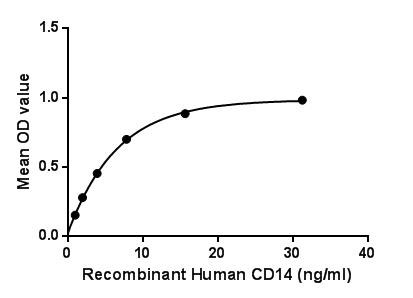
Figure. The binding activity of CD14 with LBP.
Cluster Of Differentiation 14 (CD14), also known as CD14, is a component of the innate immune system. CD14 acts as a co-receptor (along with the Toll-like receptor TLR 4 and MD-2) for the detection of bacterial lipopolysaccharide (LPS). CD14 can bind LPS only in the presence of lipopolysaccharide-binding protein (LBP). Although LPS is considered its main ligand, CD14 also recognizes other pathogen-associated molecular patterns such as lipoteichoic acid. Besides, Lipopolysaccharide Binding Protein (LBP) has been identified as an interactor of CD14, thus a binding ELISA assay was conducted to detect the interaction of recombinant human CD14 and recombinant human LBP. Briefly, CD14 were diluted serially in PBS with 0.01% BSA (pH 7.4). Duplicate samples of 100μL were then transferred to LBP-coated microtiter wells and incubated for 2h at 37℃. Wells were washed with PBST and incubated for 1h with anti-CD14 pAb, then aspirated and washed 3 times. After incubation with HRP labelled secondary antibody, wells were aspirated and washed 3 times. With the addition of substrate solution, wells were incubated 15-25 minutes at 37℃. Finally, add 50µL stop solution to the wells and read at 450nm immediately. The binding activity of CD14 and LBP was shown in Figure 1, and this effect was in a dose dependent manner.
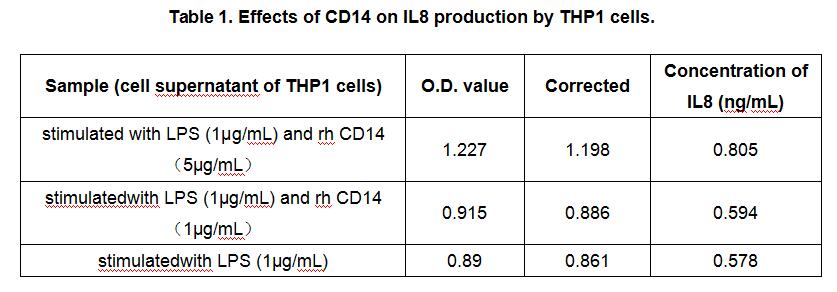
CD14 also can enhance LPS-stimulated IL-8 secretion by THP-1 human acute monocytic leukemia cells. Therefore, THP1 cells were cultured in 24 well plates at a concentration of 106 cells/mL and stimulated by LPS (1μg/mL), then added of different concentrations of recombinant human CD14 (1μg/mL, 5μg/mL). After 24h later, the production of IL8 was determined in the supernatants by cytokine specific ELISA.
Result: When the concentration of CD14 was 5μg/mL, the secretion LPS-stimulated IL-8 can be significantly increased.
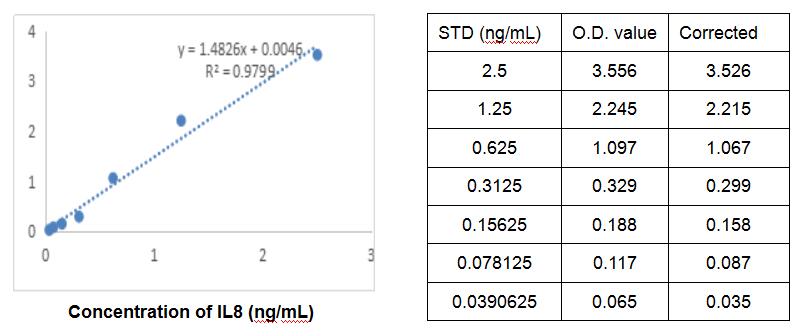
The standard curve was demonstrated as follows.
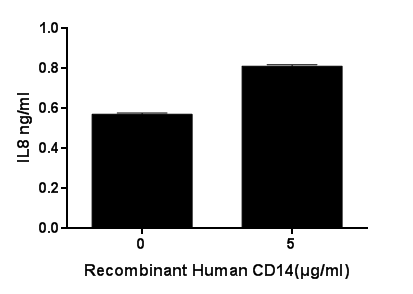
Figure. Effects of CD14 on IL8 production by THP1 cells.
Usage
Reconstitute in 20mM Tris, 150mM NaCl (pH8.0) to a concentration of 0.1-1.0 mg/mL. Do not vortex.
Storage
Avoid repeated freeze/thaw cycles. Store at 2-8°C for one month. Aliquot and store at -80°C for 12 months.
Stability
The thermal stability is described by the loss rate. The loss rate was determined by accelerated thermal degradation test, that is, incubate the protein at 37°C for 48h, and no obvious degradation and precipitation were observed. The loss rate is less than 5% within the expiration date under appropriate storage condition.
Increment services
-
 BCA Protein Quantification Kit
BCA Protein Quantification Kit
-
 Molecular Mass Marker for Protein
Molecular Mass Marker for Protein
-
 Monoclonal Antibody Customized Service
Monoclonal Antibody Customized Service
-
 Polyclonal Antibody Customized Service
Polyclonal Antibody Customized Service
-
 Protein Activity Test Experiment Service
Protein Activity Test Experiment Service
-
 Electrophoretic Mobility Shift Assay (EMSA) Experiment Service
Electrophoretic Mobility Shift Assay (EMSA) Experiment Service
-
 Buffer
Buffer
-
 Lentivirus Packaging Experiment Service
Lentivirus Packaging Experiment Service
-
 Adenovirus Packaging Experiment Service
Adenovirus Packaging Experiment Service
-
 Real Time PCR Experimental Service
Real Time PCR Experimental Service
-
 Spike RBD Protein (S-RBD)
Spike RBD Protein (S-RBD)
-
 Protein G
Protein G
-
 Protein A
Protein A
Citations
- Successful Treatment of Acute Lung Injury with Pitavastatin in Septic Mice: Potential Role of Glucocorticoid Receptor Expression in Alveolar MacrophagesAspet: 171462
- Elevated serum soluble CD15 levels in chronic HBV infection are significantly associated with HBV-related hepatocellular carcinomaPubMed: 26643894
- RHEUMATOID ARTHRITIS RELATED BIOMARKER20170350884
- Evaluating the Roles of sCD14 and sCD14-ST in Diagnosing COPD and Predicting an Acute Exacerbation of COPD






